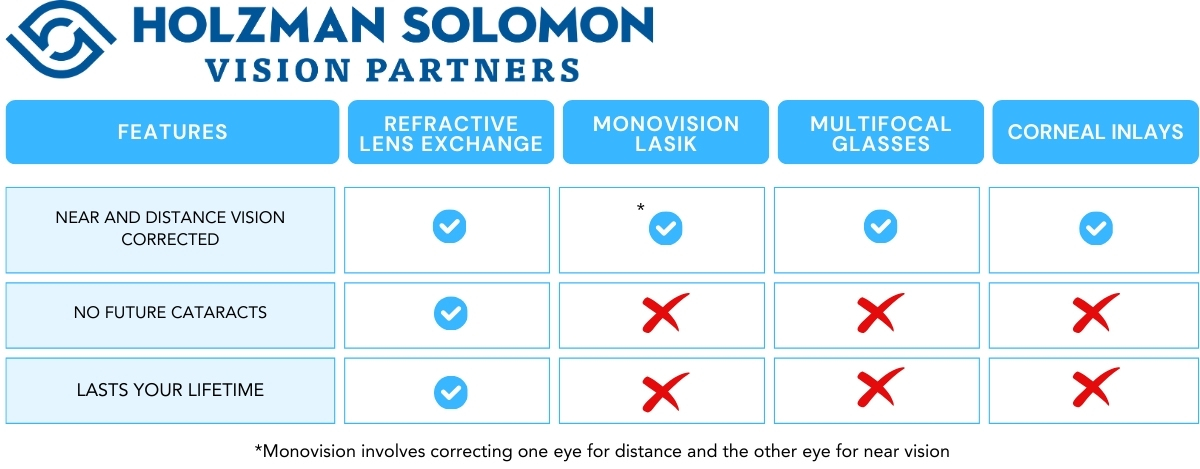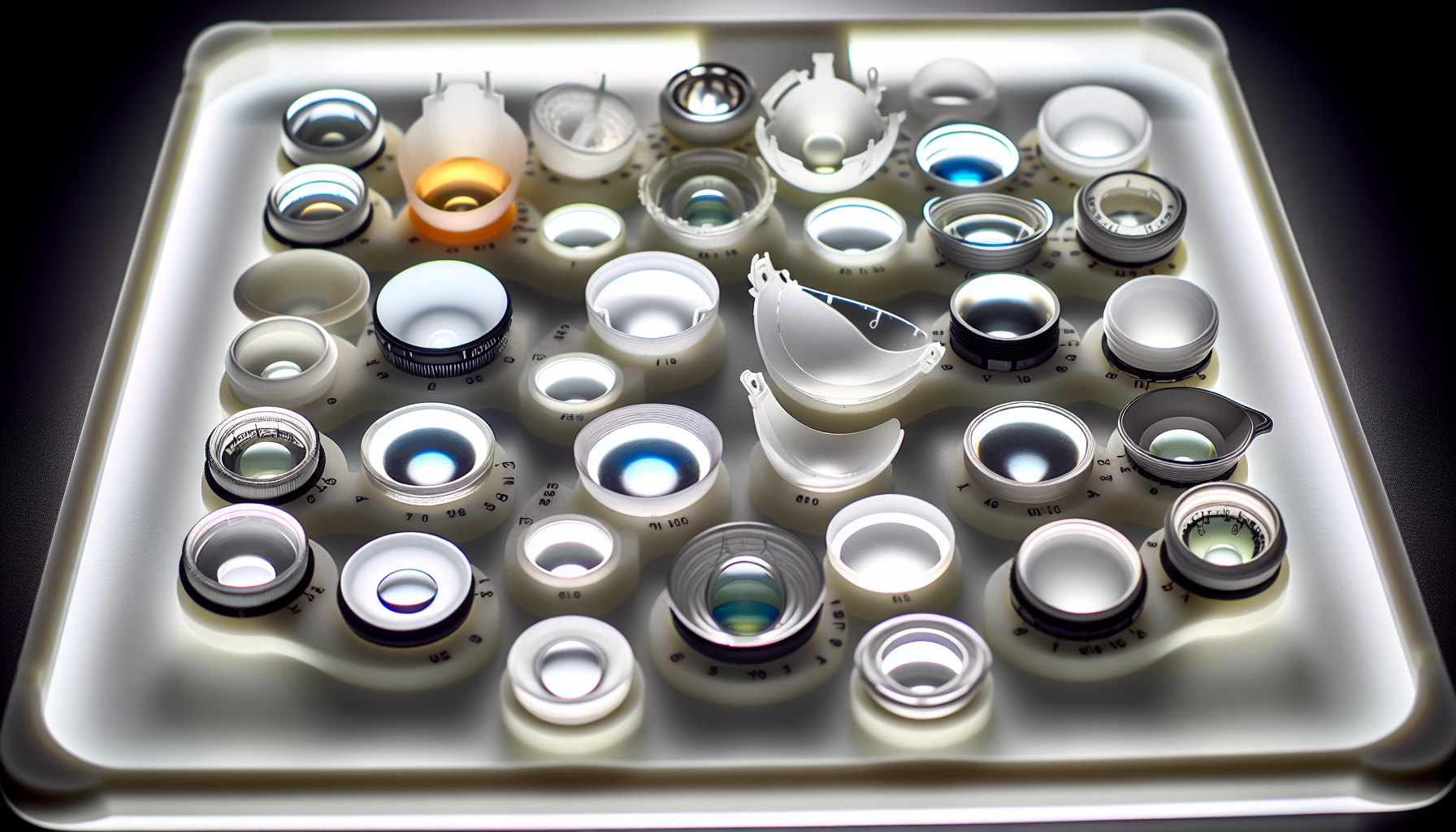Understanding Refractive Lens Exchange:
A Comprehensive Insight into Vision Correction
Understanding Refractive Lens Exchange:
A Comprehensive Insight into Vision Correction
Are you exploring refractive lens exchange as a solution to correct your vision? This procedure, often touted as an alternative to glasses or LASIK, involves replacing the eye’s natural lens with an artificial one to sharpen eyesight. It may offer a long-term fix for those over 40 or for those who have presbyopia or high refractive errors. Our comprehensive guide breaks down the process, evaluates candidacy, compares it with other correction methods, and outlines risks and financial considerations.
Key Takeaways
-
Refractive Lens Exchange (RLE) is a vision correction procedure that replaces the eye’s natural lens with an artificial intraocular lens (IOL), addressing refractive errors and reducing the need for glasses or contact lenses, especially for individuals over 45 who do not yet qualify for cataract surgery.
-
There are various IOL options available, such as light adjustable lenses, monofocal, multifocal, toric, EDOF, and accommodative lenses, each tailored to correct specific vision issues like presbyopia or astigmatism, with trade-offs in visual ranges and potential side effects like glare or halos.
-
RLE involves certain risks including infections and potential loss of vision, and while insurance typically does not cover it, the surgery offers a permanent solution that might reduce long-term costs associated with alternative vision correction methods like glasses or contact lenses.
Decoding Refractive Lens Exchange (RLE)
Refractive Lens Exchange (RLE), also known as clear lens extraction, is a voluntary outpatient procedure designed to provide a long-term solution for vision improvement by replacing the eye’s natural lens with an artificial intraocular lens. The procedure corrects refractive errors, which cause blurred vision because light is not focused properly onto the retina. As a result, patients often experience enhanced visual acuity and a comprehensive treatment for refractive errors, including improved vision at various distances.
The ideal candidate for Refractive Lens Exchange is typically over 40 years old, which is often considered the refractive lens exchange age, and has difficulty adjusting to the undesired visual side effects of alternative corrective methods such as glasses or contact lenses. The RLE procedure provides a reliable solution for presbyopia (age-related difficulty in focusing on close objects), and can also prevent or reduce cataract progression.
The Ideal Candidate for RLE
The ideal candidate for RLE should have stable vision, which implies that their vision prescription has largely remained unchanged over a certain period. This stability is key to forecast the long-term success of the RLE procedure and other treatments like laser vision correction.
Another key consideration for RLE candidacy is the overall health of the eyes. Individuals seeking RLE should have healthy eyes devoid of any history of eye disease to optimize the surgical outcomes. Moreover, RLE serves as an alternative for those individuals with thin corneas who may not be eligible for LASIK surgery. With RLE, the cornea remains unaffected, making this procedure a viable alternative for individuals with thin corneas.
Exploring Intraocular Lenses (IOLs) Options ->
The success of the RLE procedure largely depends on the choice of the intraocular lens (IOL) which replaces the eye’s natural lens. There are several types of IOLs available, each designed to meet specific visual needs and lifestyles. These include:
- Light Adjustable Lenses
-
Monofocal lenses
-
Multifocal lenses
-
Extended depth-of-focus (EDOF) lenses
-
Accommodative lenses
-
Toric lenses
-
Presbyopic-correcting lenses
Multifocal IOLs: Vision at Multiple Distances
Multifocal IOLs are designed to provide clear vision at multiple distances. These lenses function by integrating multiple focal points or zones into the lens design. This unique feature makes these lenses especially suitable for individuals with presbyopia and those who rely on reading glasses, as they offer a wider range of clear vision without the need for spectacles.
In the market today, various types of multifocal IOLs are available, including:
-
PanOptix
-
ReSTOR
-
TECNIS
-
Refractive multifocal lenses
Each type offers a decrease in the lifetime cost of glasses and contacts, as well as a reduced reliance on reading glasses or computer glasses after surgery. However, potential drawbacks include difficulty in seeing at night with the presence of glare or halo effects around lights, and the inability to correct astigmatism.
Monofocal IOLs: Focused on One Distance
Monofocal Intraocular Lenses (IOLs) are specialized intraocular lenses designed with a single fixed focus for a specific distance, often utilized in cataract surgery. These lenses are designed with a single focusing distance, allowing them to focus specifically for either up-close vision or distance vision.
The primary advantage of monofocal IOLs is that they provide exceptional visual clarity within a specific range. One of their primary benefits is the reduced occurrence of visual symptoms. However, they have limitations, such as providing clear vision in only one zone, potentially impacting depth perception, particularly in cases of monovision correction for different ranges in each eye.
Toric IOLs: Correcting Astigmatism
Toric IOLs are most appropriate for individuals with moderate to severe astigmatism. These specialized intraocular lenses work by addressing the irregular curvature of the cornea or lens in the eye, thereby reducing post-operative astigmatism and improving vision clarity following RLE surgery.
Toric IOLs are capable of correcting a broad spectrum of astigmatism, ranging from approximately 0.80 diopters (D) to as high as around 6.0 D. However, there are instances where they may not fully correct astigmatism, such as in cases of post-surgery lens shifting. Despite these limitations, patients generally achieve superior overall visual results with Toric IOLs as opposed to non-toric lens implants.
Step-by-Step: The RLE Surgical Procedure

The RLE surgical procedure is a straightforward process that includes the following steps:
1. Comprehensive eye exam to detect any underlying conditions
2. Refraining from eating after midnight the night before surgery
3. Ensuring transportation home post-surgery
4. Making a small incision to remove the eye’s old natural lens
5. Implanting the new IOL
The process of lens fragmentation during RLE surgery entails the utilization of ultrasound technology, and in some cases, it may involve the assistance of a femtosecond laser to disintegrate the old lens prior to its removal. The IOL is then carefully implanted by inserting it through the previously made incision, into the lens capsule, and positioning it to replace the old lens. The entire procedure typically takes approximately 15 minutes per eye.
Postoperative Expectations: Recovery and Vision Improvement

Following RLE surgery, patients can expect an average recovery period of about a week. Vision improvement is commonly noticed within 24 hours, with full vision benefits typically achieved within several weeks. However, it is not uncommon for patients to experience transient side effects including eye discomfort, blurred vision, glare, and occasional temporary double vision.
Patients are strongly advised to follow post-surgery instructions, including using prescribed eye drops, to ensure a smooth recovery and better vision improvement outcomes. Generally, patients can expect to get back to their regular activities about a week after the RLE surgery.
Comparing RLE to Other Vision Correction Procedures

For those contemplating RLE, it is beneficial to contrast it with other vision correction procedures. We will explore how RLE compares with LASIK surgery and the use of contact lenses.
RLE vs. LASIK Surgery
While both RLE and LASIK aim to improve visual acuity and work towards a glasses-free life, they tackle the vision correction challenge differently. RLE involves removal and replacement of the lens and is especially advantageous for patients over 40 due to age-related deterioration of eyesight. On the other hand, LASIK compensates for refractive errors by reshaping the cornea.
RLE is considered suitable for:
-
patients with high refractive errors
-
patients with age-related vision changes, i.e. presbyopia, whom do not qualify for cataract surgery.
-
individuals who are ineligible for LASIK or PRK surgery due to factors such as thin corneas
With RLE, the cornea remains unaffected, making this procedure a viable alternative for individuals with thin corneas.
RLE and Contact Lenses
Contact lenses provide a temporary solution to vision correction and require regular maintenance and replacement. RLE, on the other hand, offers a permanent solution to vision correction, eliminating the need for ongoing lens maintenance and replacement.
Contact lenses typically offer sharp visual acuity for the majority of patients, sometimes surpassing the clarity provided by glasses. However, when compared to RLE, the consistency of vision quality, particularly in near vision, may be less reliable. In addition, the long-term costs of using contact lenses can vary from $200 to $800 per year, covering expenses for lens replacement, solutions, and cases.
Financial Considerations: Cost and Insurance Coverage
The cost of Refractive Lens Exchange surgery can be a significant consideration for many. In the United States, the typical expenditure for RLE ranges from $3,000 to $8,000 per eye. Bear in mind that RLE surgery is typically not included in health insurance coverage, although some insurers may provide coverage under specific circumstances.
In most places, besides the basic expenses, there are additional charges for consultation, tests, intraocular lens, surgeon’s fee, anesthesiologist, preoperative clearance, medications before and after the surgery, facility fees, and any required touch-ups. However, in our advanced in-house surgical suite at Holzman Laser Vision, there’s no need for facility fees, anesthesiologist, or clearances. We handle all these aspects internally, which are typically unnecessary for most patients in our surgical suite.
To ensure transparency and peace of mind regarding expenses, we offer our patients a flat rate of $11,000 for both eyes, covering all the mentioned services, along with a lifetime guarantee.
Understanding the Risks: Potential Complications of RLE
As with any surgical procedure, RLE carries potential risks. Severe complications such as infections, known as endophthalmitis, occur at a low incidence of between 0.04% and 0.7%. While total loss of vision is a rare outcome, there have been reported cases which classify it as a severe yet uncommon complication.
There are several risk factors that can elevate the probability of hemorrhage occurring during or after RLE surgery. These factors include:
- Hard nuclear cataracts
- Pre-existing conditions like glaucoma
- Previously vitrectomized eyes
- The patient’s age
- The use of medications that impact bleeding
Additionally, complications of RLE surgery such as posterior capsular opacification, cystoid macular edema, and retinal detachment have the potential to lead to vision loss.
Longevity of Results: How Long Does RLE Last?
Refractive Lens Exchange surgery, also known as eye lens replacement surgery, refractive lens exchange procedure, or refractive surgery, is intended to provide a lasting solution for vision correction by replacing the eye’s natural lens with a lens implant. The intraocular lenses utilized in the procedure are designed to have a permanent and lifelong average lifespan.
However, while the majority of RLE patients achieve a high degree of glasses independence, with 80-95% not requiring glasses for most activities several years after the surgery, there are circumstances in which a lens may require replacement. This may arise from challenges in the patient’s adjustment to visual side effects or other factors.
Summary
Refractive Lens Exchange is a remarkable procedure that offers a long-term solution for vision correction. By replacing the eye’s natural lens with an artificial intraocular lens, patients can experience improved visual acuity and a reduced reliance on glasses or contact lenses. However, as with any surgical procedure, it’s important to carefully consider all factors, including potential risks and financial considerations, before deciding on RLE.
Frequently Asked Questions
Is refractive lens exchange worth it?
Yes, refractive lens exchange is worth it as it has a proven rate of predictability in achieving vision correction goals, and 95% of patients report a high level of satisfaction.
What are the disadvantages of refractive lens exchange?
Refractive lens exchange is more invasive than laser refractive surgery and carries potential complications such as retinal detachment and endophthalmitis, which are not as significant risks with PRK and LASIK.
What is the refractive lens exchange?
Refractive lens exchange is an elective outpatient surgery that removes the eye’s natural lens and replaces it with an intraocular lens (IOL). This procedure can help correct vision issues such as nearsightedness and farsightedness.
What is the average cost of refractive lens exchange?
We provide a $11,000 package for both eyes, covering consultation, testing, premium lenses, surgeon and anesthesiologist fees, pre-op clearance, medications, facility usage, and a lifetime guarantee. Our transparent approach ensures upfront cost discussions, surgeries on both eyes in one day, and assistance with insurance paperwork.
What are the benefits of Refractive Lens Exchange?
Refractive Lens Exchange offers benefits such as improved visual acuity, comprehensive treatment for refractive errors, and potential prevention of cataract progression. It can also correct presbyopia and improve vision at various distances.





